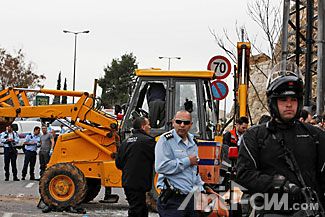|
|
本帖最后由 I'm_zhcn 于 2009-3-6 14:59 编辑
Tibetan education thrives – in exile
http://www.csmonitor.com/2009/0306/p07s03-wosc.html
By Amy Yee | Correspondent of The Christian Science Monitor from the March 6, 2009 edition

Modern ways: At Tibetan Children's Village in Dharamsala, India, curriculum has been modernized to include technological studies. Mark Sappenfield/The Christian Science Monitor/File
As Tibetans mark 50 years since China's occupation of Tibet, the exile community sees a major accomplishment in creating a network of schools that preserves their language and culture.
Dharamsala, India - In a sunny classroom in this Tibetan exile community, preschoolers stack blocks and color. One boy crouches on the floor over flashcards bearing pictures and English words. Alongside him, the sight of a little girl arranging cards with spiky Tibetan script hints that this school is anything but typical.
Some 2,000 Tibetan children live, study, and play here at the Tibetan Children's Village in Dharamsala, the Indian hill town that is the Dalai Lama's home in exile. The school, which goes through 12th grade, also has about 150 Indian, European, Japanese, and South Korean students whose parents have settled in the area.
This month, the 50th anniversary of China's occupation of Tibet, is a key one for the community. In anticipation of unrest, China has launched a "Strike Hard" campaign in Tibet and has stepped up security and arrests – though pro-Tibet protests are still erupting.
Ever since the Dalai Lama fled the invasion and set up an exile community here, his goal of autonomy for Tibet has remained elusive. But with China waging what he calls "cultural genocide" in Tibet, creating a solid education system has been central to his goal of preserving Tibetan culture.
The fact that "Tibetan exile society has established schools that function so successfully in India and provide a modern education is a considerable achievement in itself," says Elliot Sperling, an expert at Indiana University.
What began in 1960 as a ramshackle nursery for Tibetan orphans has grown into almost 80 schools across India, Nepal, and Bhutan. There are 17 TCV branches with at least 12,000 students. The system as a whole enrolls about 28,000 students and includes day schools, nurseries, vocational institutes, and training centers.
"We give an education that allows our children to grow up as Tibetans," said Thupten Dorjee, secretary-general of TCV. "The Chinese are destroying Tibetan identity. If Tibet is to survive as a race and a nation, our hope is our children."
That objective has become all the more urgent in the wake of pro-Tibet demonstrations across Tibet last March that erupted into China's worst violence in almost a decade.
TCV receives about 850 students each year who escape from Tibet. But because of an aggressive Chinese crackdown since the protests, only 20 have enrolled at TCV in the past year, says Mr. Dorjee. He also confirmed that China is pressuring parents in Tibet to bring children back from schools in India or face consequences.
The Dalai Lama regularly expounds on the importance of education. Last December in Dharamsala he told a group of 150 new arrivals from Tibet that with a "higher standard of education … we can fight for our rights."
"The reason Tibetans face so much difficulty is because we lacked education," he said. "The most important thing is to study and learn. With that we can compete in a modern world."
In spite of notable strides, Tibetan exile schools have their share of challenges. A 2005 education policy attempts to modernize curriculums and raise school standards. "The general standard is not satisfactory," said Karma Gelek Yuthok, education secretary in the exile government, citing mechanical teaching methods.
The curriculum has been redesigned to "make young minds active" and Mr. Yuthok says salaries have been raised. There is also more emphasis on teacher training.
Yet the schools must balance a modern education with preserving old ways. In 2005, they were required to teach in Tibetan through the fifth grade. English is taught as a foreign language from fourth grade but informal exposure begins much earlier.
Most of the exile schools are in India and follow local curriculum, while stressing Tibetan religion, history, geography, and language.
Twenty-one percent of TCV's graduates find work in vocational and technical education, 18 percent go into traditional crafts, and 18 percent go into "humanities," according to a TCV report. Lackluster participation in professional fields has prompted the Dalai Lama to encourage students to specialize. To that end, a new TCV college was inaugurated last month in Bangalore, India, for Tibetans shut out of India's highly competitive university admissions process.
About 70 percent of TCV's students are new arrivals from Tibet. Comprehensive schooling in Tibetan language and culture is uncommon in Tibet, where Chinese instruction dominates. In Tibet's isolated rural areas, schools are shoddy or virtually nonexistent.
Professor Sperling notes that Tibetans ultimately succeeded in establishing a strong education system in exile, "so much so that Tibetans are still trying to send their children from Tibet to India for education."
TCV encourages students to return after completing their studies. Youngsters who came to India legally with Chinese passports can return with relative ease. But those who crossed the border without papers risk arrest or interrogation if they go home.
Many former students look back fondly on their school days. Sonam Dorjee credits 13 years at TCV schools with nurturing his confidence and fostering his political activism.
Today, he is a member of the Tibetan Youth Congress and works for a Tibetan nonprofit that assists local Indians in Dharamsala.
"I had so many chances to learn so many things," says Dorjee. "I had some of my most memorable times there. Even today I want to go back." |
|